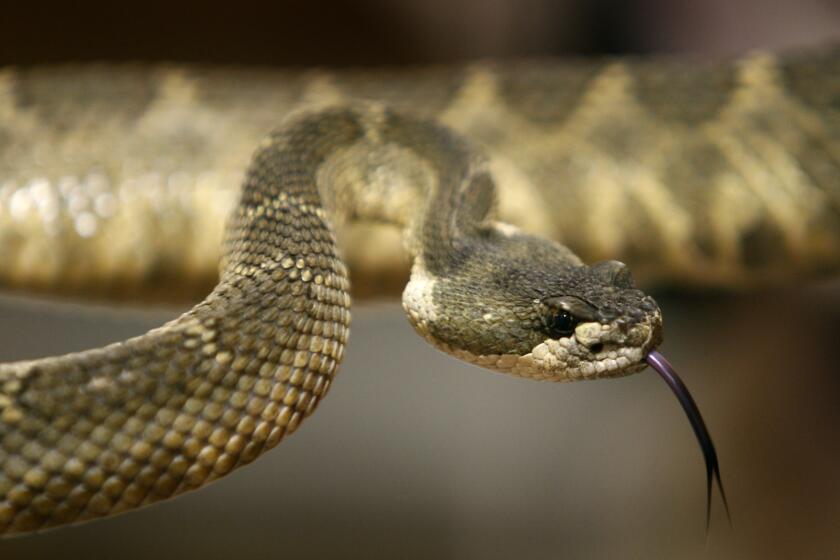Battle between birds, loggers grows in forest : Both the timber industry and protectors of a rare woodpecker are competing for the same trees.
Deep in the northern Florida woods, miles from anywhere, Jane Monaghan stands stock-still among the palmetto scrub, listening. “Nuthatches, red-bellies, chickadees, pine warblers, cardinals,” she says, ticking off the calls she’s not interested in.
Then, on the breeze whispering through the pine trees, comes the familiar squeaky chatter she has been waiting for, and Monaghan turns just in time to see a pair of dark-winged birds rocket into a silver-dollar-size hole in a nearby tree.
“There they are,” says Monaghan, 28, a biologist with the U.S. Forest Service. “The RCW, the spotted owl of the Southeast. You know, it’s always kind of a thrill to see them.”
RCW is naturalist shorthand for red-cockaded woodpecker, the rarest of American woodpeckers, and the bird that has recently become the bane of the timber industry in the Southeast, particularly in Florida. Both the woodpeckers and the loggers covet the same trees--mature, long-leaf pine trees at least 60 years old and 70 feet tall. The timber companies want the trees for high-grade board lumber and telephone poles. The birds want them for homes.
Lately, in the 180,000-acre Osceola National Forest, anyway, the birds have been winning. Long protected as an endangered species, the woodpeckers have recently benefited from new federal guidelines that increase the buffer zone around their colonies and severely reduce the acreage open to logging.
The issue--for both the birds and the loggers--is survival. “I think it’s safe to say that if we are going to survive, we’d have to rebuild the mill to do something different than we do now,” says Ron Lane, a timber buyer for Daniels Lumber Co., which employs 60 people in Lake City at the western edge of the Osceola. “People say they want more protection for these animals, but when they find out the real cost it may be too late.”
Monaghan worries that it already may be too late for the woodpeckers. Over the past two years she has identified 44 red-cockaded woodpecker clans, each containing one breeding pair and up to seven other family members, in the Osceola. But her federal mandate is to increase the number of clans to 250, and the only way to do that is preserve the old-growth trees in which the birds bore their nesting cavities.
Throughout the United States, the struggle to save endangered plants and animals while balancing the economic costs becomes more acute each day. In the Pacific Northwest, it’s the spotted owl versus the loggers. In Arizona, a red squirrel is threatened by a complex of observatories. In Wyoming, a dam project could harm whooping cranes. Just west of Miami, urban sprawl up to the edge of the Everglades makes life perilous for a host of rare creatures.
The conflict here over a small, seldom-seen woodpecker is no less critical or emotional. In 1987, two Ocala-area home builders were charged with cutting down 200 nesting trees and then shotgunning two of the birds in order to avoid legal obligations to set aside land for the birds near a planned housing development. After guilty pleas, the two were fined $300,000. Some $50,000 of that money is being used to fund Monaghan’s recovery effort.
The woodpecker is not well-known, says Monaghan, “and it’s not a cute fuzzy like the manatee. But if we lose him, it means we’re losing the habitat too. It means there would be a niche not filled, and who knows what other species may be dependent on it? I don’t think the timber interests understand.”
What the timber interests understand best are their numbers. Last year, sales from Florida’s three national forests put $8.5 million in federal coffers, a fourth of which is shared by local counties for schools and roads.
In the Osceola, the smallest of the state’s three national forests, private loggers in 1989 cut 17 million board feet of lumber. This year, because of restrictions designed to protect the woodpeckers, that figure will dip to 11 million. By 1992, the estimated total will be no more than 5 million board feet.
The Forest Service Timber Purchasers Council, an Atlanta-based group of 120 private logging companies, has filed suit, charging that the government illegally drew the more restrictive guidelines that enlarged the buffer zone from 200 feet to three-quarters of a mile, a loss to loggers of 900 acres around each colony.
Monaghan does not argue that all logging in national forests should be stopped. In fact, for the woodpeckers, removal of some trees is even desirable because the birds prefer to nest in tall pines with a clear understory.
Last year, Hurricane Hugo ripped through the Francis Marion National Forest north of Charleston, S.C., and virtually wiped out what had been the largest population of the woodpeckers. That loss, says Monaghan, makes efforts here even more critical. “We should be able to stabilize this population in the next five years and keep it from declining,” she says. “We can’t assure its survival. But at least we know what to do to help.”
More to Read
Start your day right
Sign up for Essential California for news, features and recommendations from the L.A. Times and beyond in your inbox six days a week.
You may occasionally receive promotional content from the Los Angeles Times.






